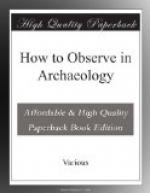5. The tool-marks of the tomb-quarriers should be examined, as they sometimes reveal interesting technical points.
6. Every inch of the surface of the excavation, inside and out, must be examined for ornaments, symbols, or inscriptions. These may be either cut or painted, and often are very inconspicuous. Ornaments are usually floral in type, though in late tombs figure-subjects are occasionally to be found. Symbols are either Jewish (the seven-branched candlestick) or Christian (the cross, A-omega, or the like). Inscriptions are not necessarily formally cut: they are sometimes mere scratched graffiti, which would be sure to escape notice unless carefully looked for (as in the so-called ‘Tombs of the Prophets’ on the Mount of Olives).
7. Dating of tombs. The savage rifling to which Palestinian tombs have been subjected has much reduced the material available for dating them. The following general principles apply to Southern Palestine: those in Northern Palestine and Syria still await a more exact study:
The earliest tombs known in the country were mere natural caves, into which the dead were cast, often very unceremoniously.
In the Second Semitic Period (circa 1800-1400 B.C.) hewn chambers began to be used. These are in the form of cylindrical shafts with a doorway at the bottom leading sideways into the burial-chamber. Natural caves are still frequently used.
In the Third Semitic Period (circa 1400-1000 B.C.) the shaft: form disappears and an artificial cave, rudely hewn out, takes its place. The entrance is in the side of the chamber, though not necessarily at the level of the floor. Rude shelves for the reception of the bodies are sometimes, but not always, cut in the sides of the chamber.
In the Fourth Semitic Period (circa 1000-550 B.C.) the tomb-chambers are of the same kind, but are as a rule smaller.
In Southern Palestine the well-made tomb-chambers, such as are to be seen in great numbers around Jerusalem, are all post-exilic. There is an immense variety in plan, some tombs being single chambers, others complications of several chambers. The late excavation absurdly called the ‘Tombs of the Kings’ at Jerusalem is quite a labyrinth of rockcut chambers. In exploring such a structure a careful search should be made for devices for deluding thieves: special precautions are sometimes taken to conceal the entrance to inner groups of chambers. There are some interesting examples of this in the cemetery in the Wadi er-Rababi, south of Jerusalem. However, all tombs of this period fall into two groups, kok tombs and arcosolium tombs. In the former the receptacles for bodies are of the kind known by the Hebrew name kokim—shafts, of a size to accommodate one body (sometimes large enough for two or three) driven horizontally into the wall of the chamber. In the normal kok tomb-chamber there are nine kokim, three in




